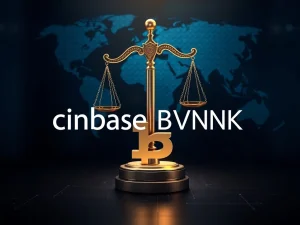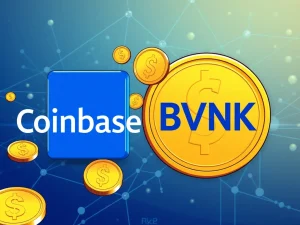Circle Digital Currency Bank: A Pivotal Leap for US Crypto Regulation

Imagine a future where digital currencies seamlessly integrate into the traditional financial system, backed by the full weight of federal oversight. This isn’t just a distant dream; it’s the ambition driving Circle, the fintech innovator behind the USDC stablecoin. Circle is making a groundbreaking move to establish America’s first Circle digital currency bank, a development that promises to reshape how we view and use digital assets.
What is Circle’s Vision for a Digital Currency Bank?
Circle has formally applied to the Office of the Comptroller of the Currency (OCC) to create a national trust institution. This proposed entity, aptly named First National Digital Currency Bank, isn’t designed to be your typical consumer bank. You won’t find traditional checking accounts or mortgage loans here. Instead, its focus is specialized and strategic:
- Safeguarding USDC Reserves: The primary function will be to directly manage and secure the vast reserves that back USDC, which currently stands at over $62 billion in circulation, making it the world’s second-largest stablecoin.
- Managing Cash and Short-Term Treasury Holdings: The bank will oversee the liquid assets that ensure USDC’s 1:1 peg to the U.S. dollar.
- Offering Digital Asset Custody Services: It will provide secure custody solutions for institutional clients, extending beyond just USDC.
Until now, Circle has relied on third-party custodians like BlackRock and BNY Mellon for reserve management. By pursuing an OCC charter, Circle aims to internalize control, streamline operations, reduce counterparty risk, and enhance transparency. This move is a clear signal of Circle’s intent to become a serious contender in global finance, aligning itself with evolving regulatory landscapes.
To better understand the distinction, consider this comparison:
| Feature | Traditional Commercial Bank | Circle’s Proposed Trust Bank |
|---|---|---|
| Primary Services | Deposits, loans, mortgages, consumer banking | USDC reserve management, digital asset custody, treasury services |
| Target Clients | Retail consumers, small businesses, corporations | Institutional clients, corporate treasuries, other financial entities |
| Regulatory Oversight | OCC, Federal Reserve, FDIC (for insured deposits) | OCC, Federal Reserve (as a national trust institution) |
| Asset Focus | Fiat currency, traditional securities | Stablecoin reserves, tokenized assets, blockchain-based instruments |
Why a Federal Charter is Game-Changing for USDC Regulation
A federal charter would fundamentally alter Circle’s standing and bolster USDC regulation. Currently, firms often navigate a patchwork of state-by-state regulations or operate under specific licenses like New York’s BitLicense. Gaining a national trust charter would elevate Circle to a federally regulated bank, subject to the direct oversight of both the OCC and the Federal Reserve.
- Enhanced Credibility: For institutions hesitant to engage with crypto-native firms, this change signals a new level of compliance, permanence, and trustworthiness. It follows the path taken by Anchorage Digital, which holds a similar crypto bank charter, but with far broader implications given USDC’s widespread adoption.
- Full Control Over Reserves: Bringing the $62.1 billion in USDC reserves in-house means Circle can directly oversee the assets backing its stablecoin. This not only adds operational efficiency but also significantly reduces counterparty risk. As trust in stablecoins increasingly hinges on transparent and secure reserve management, this move provides stronger guarantees around security, liquidity, and compliance with both US and international standards, including the Markets in Crypto-Assets (MiCA) compliance framework and the GENIUS Act stablecoin regulation.
- Alignment with Future Standards: The GENIUS Act, passed by the US Senate in June 2025, sets a new benchmark for regulated stablecoin infrastructure, mandating 1:1 reserve backing, monthly attestations, and federal oversight. By applying for a federal trust charter, Circle demonstrates its readiness to meet and even help define future US standards for digital currency banking.
Unlocking Institutional Crypto with Circle’s Trust Bank
While Circle’s new trust bank won’t offer retail deposits or lending, it will unlock a powerful suite of business-to-business opportunities, significantly expanding the landscape for institutional crypto adoption. With federal approval, Circle could expand its digital asset custody services not just for USDC, but for a broader range of tokenized assets, corporate treasuries, and other blockchain-based financial instruments.
This positions Circle to develop into essential payment infrastructure, effectively bridging the gap between traditional finance (TradFi) and Web3. As firms globally, from Europe to the United Arab Emirates, pursue licenses like the Abu Dhabi crypto license, Circle’s US-based trust bank could serve as a model for structural alignment with both US stablecoin legislation and global compliance norms.
Did you know? In 2024, USDC surpassed Tether’s USDt (USDT) in on-chain transaction volume, despite having a smaller market capitalization, highlighting its growing utility in institutional flows.
The Path to a Stablecoin Federal Charter: Timing is Everything
Circle’s decision to pursue a stablecoin federal charter now feels like a precisely calculated move, benefiting from converging market and regulatory conditions. Investor confidence has surged following Circle’s blockbuster initial public offering (IPO) and new federal rules are providing a clear regulatory path forward for stablecoins.
- Market Validation: Circle’s June 5 debut on the New York Stock Exchange (ticker: CRCL) sent a clear message that markets are ready to back a regulated stablecoin issuer. The stock opened at $69, more than doubling its $31 listing price, and briefly topped $100 before settling at $83. That day, Circle NYSE IPO CRCL closed with a market capitalization near $6.9 billion and nearly 200% growth, reflecting soaring demand for companies that sit at the intersection of TradFi and DeFi.
- Regulatory Clarity: Just 12 days after Circle’s IPO, Washington provided its strongest nod yet to stablecoin regulation with the passage of the GENIUS Act. This legislation established comprehensive guardrails: 1:1 dollar backing, real-time attestations, and oversight by federal banking regulators such as the OCC.
- Supportive Regulators: Under Acting Comptroller Rodney Hood, the OCC has signaled support for responsible crypto integration, particularly through the Circle OCC charter application process. This regulatory environment creates an opportune moment for Circle to make its ambitious play.
Did you know? Circle earned roughly $1.7 billion in interest income in 2024, almost entirely from holding USDC reserve assets, underscoring the financial viability of its stablecoin operations.
The Broad Impacts of OCC Approval: A New Era for Digital Assets
Should Circle secure OCC approval for its digital currency bank, the ripple effects could be transformative, unlocking institutional access, fueling USDC adoption, and fundamentally altering how stablecoins integrate into the global financial system.
- Bridging Stablecoins and Traditional Institutions: As a federally regulated bank, Circle would serve as crucial connective tissue between the crypto world and established finance. Pension funds, asset managers, and insurers often require federally supervised partners before engaging with digital assets. A Circle digital currency bank, governed under OCC oversight, could unlock these previously inaccessible channels. Much like how money market funds gained mainstream acceptance after tighter regulations boosted trust, Circle aims to make USDC reserve management a benchmark for stability and reliability.
- Accelerating Real-World Stablecoin Use: A key advantage of a Circle stablecoin bank is the potential for seamless integration. Institutional-grade digital asset custody services would directly support a wider range of applications, including tokenized securities, real-time payments, and sophisticated programmable finance. With partners like Visa, Stripe, and BlackRock already experimenting with Circle payment infrastructure, the next phase involves deeper adoption—think OAuth-style plug-and-play modules that allow banks and fintechs to offer USDC services with minimal friction.
- Industry-Wide Impacts: Circle’s charter could pave the way for a new category of federally recognized crypto bank charter holders. Legacy firms like JPMorgan and Bank of America are reportedly exploring jointly issuing a stablecoin. A successful Circle trust bank would validate this model, encouraging competitors to seek their own national trust charter crypto approvals. This broader impact would lead to stronger interoperability across the digital asset ecosystem, more robust compliance frameworks, and increased investor confidence in the regulated crypto space.
Did you know? Stablecoins facilitated an estimated $27.6 trillion in transactions in 2024, surpassing the combined volume of Visa and Mastercard by about 7.7%, highlighting their rapidly growing importance in global payments.
Conclusion: A New Horizon for Digital Finance
Circle’s pursuit of America’s first digital currency bank marks a pivotal moment for the cryptocurrency industry. By seeking federal oversight, Circle is not just expanding its business; it’s actively working to define the future of regulated digital finance. This move promises to enhance trust, unlock institutional capital, and accelerate the real-world utility of stablecoins like USDC. For regulators, institutions, and global partners, Circle’s initiative sets a powerful precedent: stablecoins can evolve into bank-grade, fully regulated infrastructure, paving the way for a more integrated and secure digital financial ecosystem.







